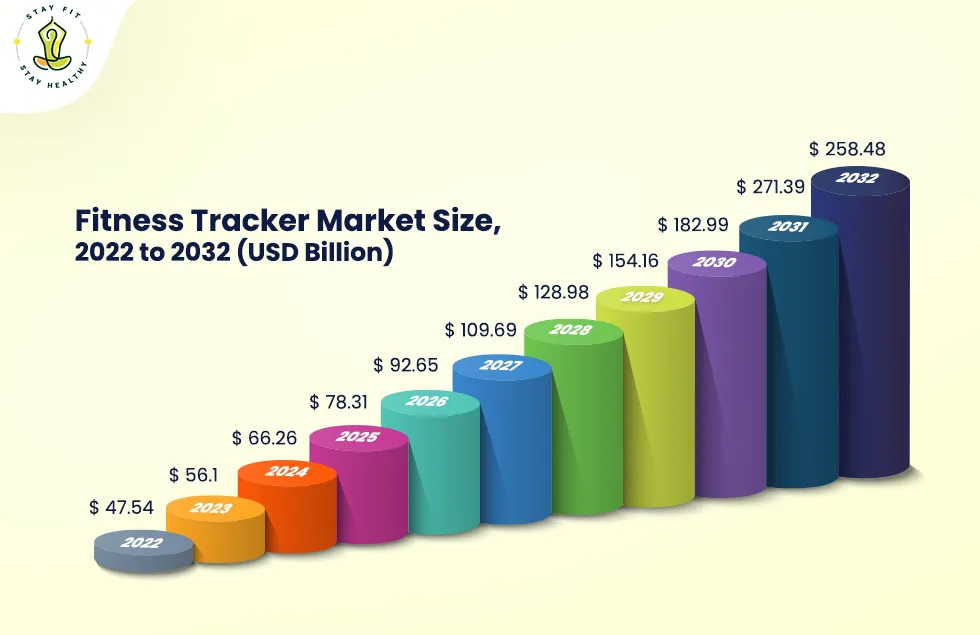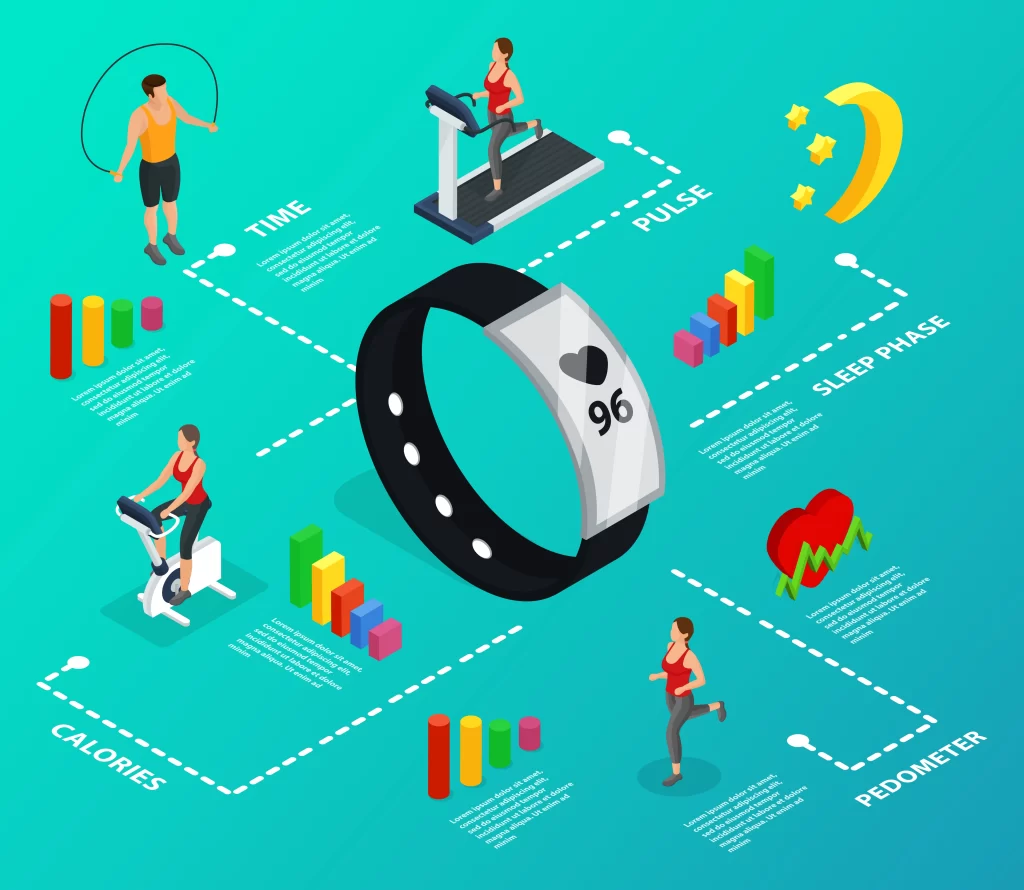Most home workouts stop within 3 months and gym membership within 6.
Reason?
There can be many but the most common reason for quitting is Lack Of Motivation. We start highly motivated, influenced by social media influencers or celebrities with perfect bodies but slowly the motivation wears off and so does your will to workout.
So how can beginners stay motivated for a longer period of time
Fitness Trackers
A fitness tracker is a health device that uses technology to help you keep your fitness in check. In recent years, fitness trackers have evolved from simple step counters to sophisticated devices powered by artificial intelligence (AI) that give personalized results as per individual’s need. These AI-powered fitness trackers are revolutionizing the way we approach health and wellness.
This blog aims to provide a detailed understanding of fitness trackers. We’ll have a look at its advantages, features, and most importantly, is it really worth the buy??
Understanding Animal-Based Protein: Balancing Benefits and Risks
 (Source: stayhealthyandstayfit.com)
(Source: stayhealthyandstayfit.com)
History of Fitness Trackers
Before fitness trackers, people mainly relied on periodic check-ups with healthcare professionals to monitor their health. While not constantly measuring health isn’t inherently wrong it can be a bit expensive.
The introduction of fitness trackers like the Fitbit in the early 2000s marked the first significant leap. The impact of these fitness trackers has been profound. They have democratized health data, making it accessible to everyone, and have encouraged millions to adopt healthier lifestyles through increased awareness and motivation.
Fitness Tracker Vs. Smartwatches
| FEATURE | FITNESS TRACKER |
SMARTWATCH |
| Purpose | Health and fitness monitoring | Smartwatches are multifunctional (notifications, apps, fitness and tracking). |
| Design | Minimalist design | Bulkier and has high-resolution display |
| Battery Life | Longer battery life | Shorter battery life |
| Health Tracking Features | Measuring heart rate, sleep, steps and calorie count | May vary according to different brand |
| Additional Features | Basic phone notification | Features like calls, messages, apps and music can be used. |
| Price Range | Usually affordable | More expensive |
How Does A Fitness Tracker Work?
Fitness trackers use various technologies to monitor different health metrics. Here’s a breakdown of how they measure heart rate, calorie count, sleep quality, and step count:
1. Heart Rate Monitoring
Optical Heart Rate Sensors:
Technology: Fitness trackers often use photoplethysmography (PPG), which involves shining LED lights (usually green) onto the skin. Sensors detect changes in light absorption caused by the pulsing of blood vessels.
Process: When the heart pumps blood, it increases the volume of blood in the wrist, changing the amount of light reflected back to the sensor. The tracker calculates heart rate based on these fluctuations.
2. Calorie Count
Accelerometers:
Technology: Accelerometers detect motion and acceleration in three dimensions. By analyzing the intensity and type of movement, fitness trackers estimate the number of calories burned.
Process: Trackers use algorithms that account for various factors, such as activity type, duration, and intensity, to estimate calorie expenditure.
Heart Rate Data:
Technology: Some trackers use heart rate data in conjunction with movement data to provide more accurate calorie estimates.
Process: Higher heart rates generally correlate with higher calorie burn, so the tracker combines heart rate and activity level to estimate caloric expenditure.
3. Sleep Quality Monitoring
Accelerometers:
Technology: Similar to step counting, accelerometers track movement to determine sleep patterns.
Process: By monitoring the frequency and intensity of movements, the tracker can estimate sleep stages (light, deep, REM) and detect periods of wakefulness.
Heart Rate Variability (HRV):
Technology: Some trackers use heart rate variability to assess sleep quality. HRV refers to the variation in time between successive heartbeats, which can indicate different sleep stages.
Process: Trackers analyze HRV patterns to provide insights into sleep quality and overall restfulness.
4. Step Counting
Accelerometers:
Technology: Accelerometers are the primary technology used for counting steps.
Process: They detect the motion of the wrist or body in three dimensions. The tracker uses algorithms to differentiate between steps and other movements, counting each step based on specific patterns and accelerations.
By combining these technologies, fitness trackers offer a comprehensive view of physical activity, health, and wellness. If you have any specific questions about a particular type of technology or how it works, feel free to ask!
Advantages of Fitness Trackers
 (Source: freepik)
(Source: freepik)
There are many success stories when it comes to fitness watches. Many individuals openly talked about how the measurements like step count and calorie count have helped them lose weight, get fit, and, in some cases, identify health problems before they worsened. Here are some of the advantages of investing in a fitness tracker:
- Motivation: Sometimes we have time and resources; all they lack is a little push. Some motivation. Seeing real-time progress and receiving notifications can motivate users to stay active and reach their fitness goals.
- Accountability: Tracking daily activity levels helps users stay accountable to their fitness routines.
- Personalized Insights: AI-powered trackers provide personalized feedback based on your readings and provide recommendations based on individual health data.
- Health Monitoring: Continuous tracking of metrics like heart rate and sleep patterns has been proven very helpful to potential health issues early.
Goal Setting: As you are able to get readings for your heart rate, steps, and calorie count, you, along with your nutritionist, can set goals for your health journey.
Why More and More People Are Using Fitness Trackers
 (Source: stay fit stay healthy)
(Source: stay fit stay healthy)
The increasing popularity of fitness trackers can be attributed to several factors. Here are some of the most common reasons for this increase in popularity:
Technological Advancements
The technology behind fitness trackers has significantly evolved, leading to improved accuracy and new features. Enhanced sensors and algorithms ensure that the data collected, such as heart rate, sleep patterns, and calories burned, is highly accurate, giving users confidence in the information they receive.
Health Awareness
Fitness trackers have proven to have amazing physical benefits for an individual, and as many studies have shown, excellent physical health leads to improved mental health. With rising concerns about sedentary lifestyles and related health issues, people are increasingly seeking out tools to help them stay fit and healthy.
Customization
One of the key advantages of fitness trackers is their ability to offer personalized data and recommendations. These devices can adapt to different fitness levels and goals, providing users with tailored insights and advice. Whether someone is a beginner looking to increase their daily steps or an athlete training for a marathon, fitness trackers can provide relevant and specific guidance.
Affordability
As technology continues to advance, fitness trackers are becoming more affordable. What was once considered a luxury item is now accessible to a broader audience. This affordability allows more people to take advantage of the benefits that fitness trackers offer. The price may range from $25 to $550. The price will depend on the number of features available in the tracker.
How Do the Features of Fitness Trackers Enhance Your Workout?
Modern fitness trackers come packed with features that cater to a variety of health and fitness needs:
- Activity Tracking
Fitness trackers monitor steps taken, distance traveled, and active minutes throughout the day. These metrics provide a clear picture of daily physical activity levels, helping users set and achieve fitness goals. Advanced trackers can differentiate between types of activities, such as step tracking, running, cycling, and more, offering detailed insights into specific exercises.
- Heart Rate Monitoring
Continuous or on-demand heart rate tracking allows users to monitor their cardiovascular health. This feature is essential for understanding how different activities affect heart rate, checking individuals workout intensity, and ensuring that users stay within their optimal heart rate zones for maximum benefit.
- Sleep Tracking
Sleep tracking features analyze sleep duration and quality by monitoring movement and heart rate during sleep. Users receive detailed reports on their sleep patterns, including the time spent in different sleep stages (light, deep, and REM sleep). This information helps users identify factors affecting their sleep and make adjustments to improve sleep hygiene and overall restfulness.
- Calorie Tracking
In a fight between choosing healthy food that is not very delicious and delicious food that is not healthy, the latter wins most of the fights. To control yo Fitness brackets estimate the number of calories burned throughout the day based on activity levels, heart rate, and personal metrics such as age, weight, and gender. This feature helps users manage their energy balance, whether their goal is weight loss, maintenance, or gain.
- Water Resistance
Water-resistant design makes many fitness trackers suitable for swimming and other water activities. Waterproof ratings vary, with some trackers capable of withstanding shallow water exposure (e.g., showers and splashes), while others are suitable for swimming in pools or open water. Swim-specific trackers also include features such as lap counting, stroke detection, and swim efficiency analysis.
- AI Insights
AI-powered fitness trackers provide personalized recommendations and feedback based on user data. These insights can include suggestions for workouts, recovery tips, sleep improvement strategies, and dietary advice. By analyzing patterns and trends in the collected data, AI can help users optimize their fitness routines and overall health. These insights can include suggestions for:
- Workouts
- Recovery tips
- Sleep improvement strategies
- Dietary advice.
By analyzing patterns and trends in the collected data, AI can help users optimize their fitness routines and overall health. This continuous learning process empowers users to make informed decisions about their health, leading to more effective goal-setting and improved long-term wellness outcomes.
Fitness Trackers to Match Every Fitness Journey
Some fitness trackers are specifically designed for specific purposes. Here are some of the different types of fitness trackers:
1. For Gym Enthusiasts
 (Source: stay fit stay healthy)
(Source: stay fit stay healthy)
Overview: Fitness tracker bracelets
for gymgoers are tailored to provide detailed insights into indoor workouts and strength training. These trackers offer robust activity monitoring and often come with features that can:
- Tracks steps, calories burned, and general activity levels throughout the day.
- Includes modes for various gym activities like weightlifting, cardio, and HIIT.
- Provide metrics like workout duration, sets, reps, and rest periods.
2. For Swimmers
 (Source: stay fit stay healthy)
(Source: stay fit stay healthy)
Overview: Swimmers need fitness trackers that can withstand water exposure and provide detailed swim metrics. These trackers are designed to function effectively underwater and offer features tailored to swimming. Their key features include:
- Ensuring the tracker can be submerged in water without damage, typically with a water resistance rating suitable for swimming.
- Monitoring metrics like lap count, stroke count, distance, and swim efficiency.
- Identifying different swimming strokes (freestyle, breaststroke, backstroke, butterfly) and providing detailed analysis.
3. For Athletes
 (Source: stay fit stay healthy)
(Source: stay fit stay healthy)
Overview: Athletes require fitness trackers that offer advanced features to enhance performance and recovery. These trackers are equipped with high-end technology to provide in-depth analysis and support training goals.Their key features include:
- Providing accurate location tracking for outdoor activities like running, cycling, and hiking.
- Measuring the maximum amount of oxygen the body can utilize during intense exercise, which is a key indicator of cardiovascular fitness.
- Offering detailed metrics such as pace, cadence, and training load to optimize workouts and recovery.
Are Bursting Common Myths Related To Fitness Trackers
Myths and misconceptions about fitness trackers can lead to unnecessary concerns. Here’s a look at some common myths and the reality behind them:
| MYTHS |
REALITY |
| Fitness trackers are not accurate. | Modern fitness trackers use advanced sensors and algorithms to provide highly accurate data. |
| Fitness trackers are only for athletes. | Fitness trackers cater to a wide range of users, from casual walkers to serious athletes, offering features and insights that benefit everyone. |
| Fitness Trackers Can Replace Medical Devices | Fitness trackers are valuable tools for monitoring general health and fitness, but they are not a replacement for medical devices. |
Are Fitness Trackers Really Worth Your Money?
While these fitness devices have numerous advantages, there are several things that may need your immediate attention:
- When you use a fitness tracker, everything related to health revolves around numbers. Heart rates, calorie count, BPM, and more. If the numbers are not met, it can lead to problems like anxiety and feelings of demotivation.
- Almost all the trackers are gamified to a level where it can be addictive. Manufacturers keep adding more and more features that might be more focused on attracting customers than health.
- There have been multiple data leaks through fitness trackers. While this may not seem like a great deal for common folks, this data is sold to advertisers who later convince us to buy products we don’t want. That being said, it is also important to note that the data security shields are much better in recent models and as technology progresses, so will the security features of the watch.
- A study by the American Medical Association concluded that people wearing wearable technology lost less weight compared to people who were more focused on working out and having a balanced diet rather than getting obsessed over numbers and measurements.
Conclusion
AI-powered fitness trackers are transforming the way we approach health and wellness. By providing personalized insights, motivation, and accountability, these devices help users achieve their fitness goals and maintain healthier lifestyles. With a wide range of options available, there’s a fitness tracker to suit every need, from casual users to professionals. As technology continues to advance, the capabilities and benefits of fitness trackers will only continue to grow, making them an essential tool in the pursuit of overall well-being.
That being said, it is also necessary to not get obsessed over the device. Being consistent with your workout and with or without fitness devices is enough to keep yourself fit and healthy. While the fitness tracker is not the perfect device out there, it has shown promises of getting better with time.
If you are a health enthusiast and want to learn more about health and fitness, subscribe to StayFit StayHealthy.

